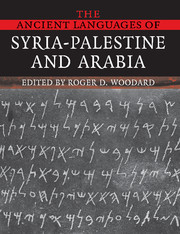Book contents
- Frontmatter
- Contents
- List of figures
- List of tables
- List of maps
- List of contributors
- Notes on numbering and cross-referencing
- List of abbreviations
- Preface
- Preface to the first edition
- Map
- 1 Language in ancient Syria-Palestine and Arabia: an introduction
- 2 Ugaritic
- 3 Hebrew
- 4 Phoenician and Punic
- 5 Canaanite dialects
- 6 Aramaic
- 7 Ancient South Arabian
- 8 Ancient North Arabian
- Appendix 1 Afro-Asiatic
- Appendix 2 Full tables of contents from The Cambridge Encyclopedia of the World's Ancient Languages, and from the other volumes in the paperback series
- Index of general subjects
- Index of grammar and linguistics
- Index of languages
- Index of named linguistic laws and principles
1 - Language in ancient Syria-Palestine and Arabia: an introduction
Published online by Cambridge University Press: 22 September 2009
- Frontmatter
- Contents
- List of figures
- List of tables
- List of maps
- List of contributors
- Notes on numbering and cross-referencing
- List of abbreviations
- Preface
- Preface to the first edition
- Map
- 1 Language in ancient Syria-Palestine and Arabia: an introduction
- 2 Ugaritic
- 3 Hebrew
- 4 Phoenician and Punic
- 5 Canaanite dialects
- 6 Aramaic
- 7 Ancient South Arabian
- 8 Ancient North Arabian
- Appendix 1 Afro-Asiatic
- Appendix 2 Full tables of contents from The Cambridge Encyclopedia of the World's Ancient Languages, and from the other volumes in the paperback series
- Index of general subjects
- Index of grammar and linguistics
- Index of languages
- Index of named linguistic laws and principles
Summary
Pedra
It seems no work of man's creative hand,
By labor wrought as wavering fancy plann'd,
But from the rock as by magic grown,
Eternal, silent, beautiful, alone!
Not virgin-white like the old Doric shrine
Where erst Athena held her rites divine;
Not saintly-grey, like many a minster fane,
That crowns the hill, and consecrates the plain;
But rosy-red as if the blush of dawn
That first beheld them were not yet withdrawn;
The hues of youth upon a brow of woe,
Which man deemed old two thousand years ago.
Match me such marvel save in Eastern clime,
A rose-red city half as old as Time.
John William BurgonOften rehearsed, sometimes parodied, there remains something hauntingly arresting about John William Burgon's sonnet in praise of Petra, Jordon's “rose-red city,” lying at the threshold of the Arabian Peninsula, on the southeastern fringe of ancient Syria-Palestine (the term is used herein to denote the region encompassing the modern political states of Jordon, Israel, Lebanon, and Syria; on the notion of “Syria-Palestine,” a geographic construct popularized by W. F. Albright, see Dever 1997). Now home to a Bedouin community, Petra was once the thriving capital city of the ancient Nabataeans, whose kingdom flourished in the late centuries BC and the early centuries AD.
- Type
- Chapter
- Information
- Publisher: Cambridge University PressPrint publication year: 2008
- 1
- Cited by

